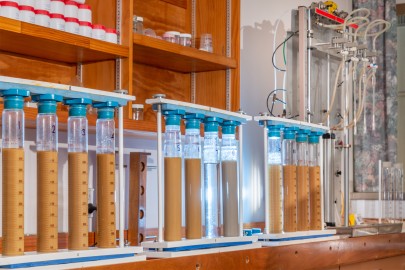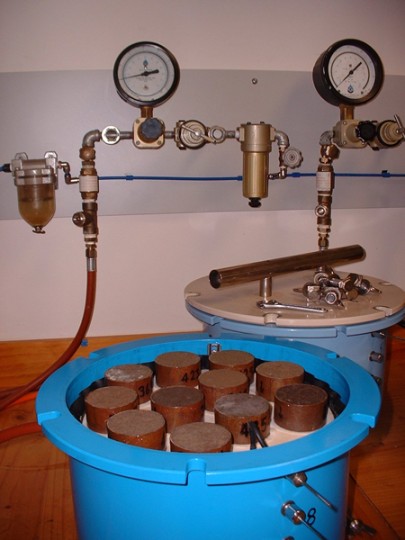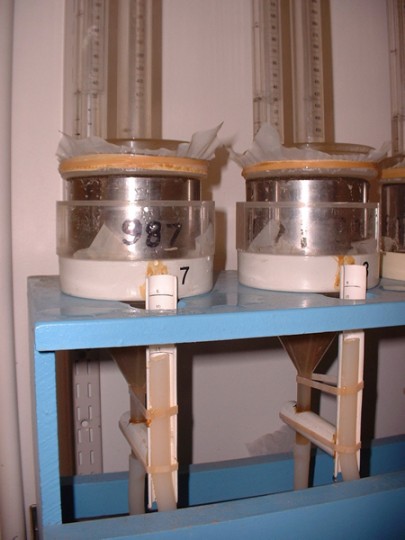Laboratory tests
In this section
* Test available only at Palmerston North
# Test available only at Hamilton
Particle-Size Analysis

Particle size analysis
The particle size of the fine earth fraction (<2.00 mm) of soil is measured using the pipette method. Samples are pre-treated to remove organic matter and calcium carbonate if necessary. Dispersion is effected by ultrasonic vibration of an immersed probe and a chemical dispersant agent.
The coarser fraction (>63 µm) is wet sieved, dried and shaken through a stack of sieves between sizes 2.00 mm and 63 µm.
The remaining soil is suspended in a column and, after initial shaking, pipette samples are drawn at various times from a set depth. The concentration of particles in each pipette is determined. These contain only particles of diameter finer than pre-determined sizes (as determined by Stokes’ equation).
Size fractions are expressed as a percentage of the total mass of sample. A grading curve is produced and a table giving sand/silt/clay percentages.
Note: 50 ml of representative soil will often be enough for analyses but please contact us to discuss appropriate sample sizes.
Reference:
Claydon JJ 1989. Determination of particle size in fine grained soils – pipette method. DSIR Division of Land & Soil Sciences Technical Record LH5.
Solid/Void Ratio Determinations
Dry bulk density is measured on an undisturbed soil sample of known volume. Samples are most often taken in a core liner that may also be used for moisture-release analyses. Note: Loose samples, of known volume when undisturbed, can be accepted for this measurement but cannot then be used for moisture release analyses.
Particle density is measured on a loose soil sample that is representative of the bulk density sample. Often this sample is taken from a dry bulk density sample.
Total porosity is the proportion of soil volume occupied by voids. It is calculated after dry bulk density and particle density have been determined.
Moisture Release Characterisation

Pressure vessels used for moisture release analyses
Moisture release analyses (Soil Water Characteristic Curve) relates soil water content to matric potential. Undisturbed core samples are saturated and subjected to controlled draining up to a matric potential of –1500 kPa.
For 0 to –10 kPa analyses, samples are placed on a ceramic plate under a suction created by a hanging column of water. For –20 to –1500 kPa analyses, separate, smaller samples are placed on a ceramic plate in a pressure extractor.
Any pressure potential between 0 and –1500 kPa may be measured but typical points are –5 kPa (for Macroporosity), –10 kPa (for Air Capacity, Field Capacity and upper limit of AWC), –20 or –33 kPa, –100 kPa (for the lower limit of RAWC), –300 or –500 kPa, –1500 kPa (for Wilt point – the lower limit of AWC).
A moisture release curve (Water desorption curve, pF curve) can be created using these data and help characterise a soil.
Analyses listed under Solid/Void Ratio Determinations are included with moisture release analyses.
Notes on terminology
For a full description of terms see Glossary of soil physical terms.
100 kPa = 1 bar
Available Water Capacity (AWC), sometimes called Available Water-holding Capacity, is the proportion of soil volume drained between pressure potentials of –10 and –1500 kPa.
Readily Available Water Capacity (RAWC) is the proportion of soil volume drained between pressure potentials of –10 and –100 kPa.
Field capacity (FC) is the volumetric water content (θ) of a soil after rapid draining ceases. In the lab it is measured as θ at a pressure potential of –10 kPa. Note: Overseas literature may use a different pressure potential.
Air Capacity (AC) is the proportion of soil volume drained between pressure potentials of 0 and –10 kPa. At this point pores >30 µm are drained.
Macroporosity (MP) is the proportion of soil volume drained between pressure potentials of 0 and –5 kPa. At this point pores >60 µm are drained. This measurement is a key indicator when monitoring soil health/structure. Note: Literature from overseas may use a different pressure potential.
References:
Gradwell MW 1972. Methods for physical analysis of soils. New Zealand Soil Bureau Scientific Report 10C.
McQueen DJ 1993. Glossary of soil physical terms. Lower Hutt, Landcare Research.
Hydraulic Conductivities

Testing for unsaturated hydraulic conductivity
Saturated hydraulic conductivity (Ksat) is the rate at which soil conducts water when saturated, i.e. all soil pores are full. Intact cores are expertly sampled and prepared before saturating in a laboratory apparatus that measures the flow of draining water maintained under a head of 10 mm.
Unsaturated hydraulic conductivity (Kus) is the rate at which soil conducts water when pores down to a certain size are non-conducting, i.e. empty. Intact cores are placed on an apparatus that applies a tension (suction) to the upper and lower surfaces and measures the flow of water conducted through the water-filled pores. A common measurement is near-saturated hydraulic conductivity (K-40) where pores >750 µm are non-conducting, i.e. exclude cracks, worm channels. Other measurements include K–20, where pores >1.5 mm are non-conducting, and K–100, where pores >300 µm are non–conducting*.
Core samples are usually 100 mm diameter and 75 mm high and can be used for both saturated and unsaturated hydraulic conductivity measurements.
References:
Klute A, Dirksen C 1986. Hydraulic conductivity and diffusivity: laboratory methods . In: Klute A ed. Methods of soil analysis: Part 1 Physical and mineralogical methods. 2nd edn. Madison, WI, ASA & ASSS. Pp. 687–734.
Cook FJ, Lilley GP, Nunns RA 1993. Unsaturated hydraulic conductivity and sorptivity: Laboratory measurement. In: Carter MR ed. Soil sampling and methods of analysis. Boca Raton, FL, Lewis Publishers.. Pp. 615–624.
Potting Mix Analyses
Potting media are tested to specific requirements and terminology used should not be confused with those used for soils.
Determination of air-filled porosity and total water-holding capacity is carried out using Australian Standards.
Reference:
Australian Standards, Potting Mixes, AS 3743–2003, Sydney, Australia, Standards Australia International Ltd.
Greenroof Substrate Analyses*
Greenroof substrate can be analysed to the German FLL standard with the following tests:
- Apparent density, maximum water capacity, Water permeability, Total pore space and Air volume.
References:
Guideline for the planning, execution and upkeep of green-roof sites 2008. Bonn, Germany, Forschungsgesellschaft Landschaftsentwicklung Landschaftsbau E. V. FLL
Raingarden Mix Physical Analyses*
Raingarden media are analysed on mixtures ‘as received’ or, more commonly, as a series made up of various proportions of sand, soil, compost or bark, determined by the client. The best performing mix is then selected for use in the raingarden.
The standard followed is either Monash University’s ‘Guidelines for filter media in biofiltration systems’ developed by Facility for Advancing Water Biofiltration (FAWB) or individual council guidelines. Note: the FAWB guide is designed for sandy soils/media. The test requires media to be brought to a wet state (-3 kPa matric potential) before compaction. Media containing a silt/clay component will be severely compacted under these conditions resulting in low permeability rates.
Important physical parameters are:
- saturated hydraulic conductivity (mm/h) – indicates the rate at which rainwater will permeate the raingarden,
- total water holding capacity (%) – the higher the capacity the more water available to plants growing in the garden,
- particle size distribution (% for size ranges) – helps determine the balance between permeability and water holding capacity,
- wilt point – determines actual volume of water available to plants.
Reference:
Monash University 2009. Guidelines for filter media in biofiltration systems (vers. 3.01). Monash Unversity, Melbourne, Australia, Facility for Advancing Water Biofiltration (FAWB). http:www.monash.edu.au/fawb/products/index.html
Water stability of soil aggregates*
Water stability of soil aggregates is an important physical characteristic of cultivated soils. It measures the extent to which the small soil crumbs produced by cultivation are likely to remain intact and separate from one another through subsequent rain and mechanical disturbance.
Analysis is carried out on the 2.00 – 4.00 mm aggregate fraction of an air-dried sample. 50 g of soil, oven-dried equivalent weight, is placed on the top sieve of a 2.0, 1.0, and 0.5 mm sieve stack, submerged in water and sieved mechanically for 30 minutes. The aggregates retained on each sieve are collected, oven-dried and weighed. Aggregates are dispersed and any remaining primary particles are sieved and weighed in a similar manner. Aggregates minus their primary particles are calculated as weight fractions of the soil initially taken.
Note on sampling:
Samples may be taken with a spade as a cube-shaped block of relatively undisturbed soil (natural cracking and breaking is OK). Use as little cutting action as possible. Make up a sample from at least three sites. Aggregate stability changes with depth, so be consistent with sample depth and/or horizon. For transport, fit the composite sample into a 2-L ice-cream container or similar.
Reference:
Gradwell MW 1972. Water stability of soil aggregates – C5.A. Wet-sieving test: methods for physical analysis of soils. New Zealand Soil Bureau Scientific Report 10.
Aggregate Size*
Aggregate size tests are used in determining and monitoring the structural state of a soil. Degradation of soil structure will result in an increase in the proportion of larger sized aggregates.
A 15-cm cube of soil sample is broken down to its natural structure and air-dried. The sample is sieved by hand to 63 microns. The sample retained on each sieve is weighed and recorded. Results are reported for % aggregate size, cumulative % aggregate size, and mean weight diameter.
We have a full range of test sieves (certified to BS 410 standards) from 31.5 mm to 0.063 mm in half φ increments (increase of one φ = half sieve mesh size).
Materials other than soils typically analysed for particle size using dry sieving are sand, bark, and raingarden/roofgarden substrates.
Materials containing a high percentage of organic based material, i.e. composts, bark, are sieved to 63 microns. They are not suitable for <63 micron analyses using the pipette method listed under Particle Size Analyses.
For sampling notes follow those for water stability of soil aggregates.
Reference:
Folk RL 1968. Petrology of sedimentary rocks. Austin, TX, Hemphill’s.
Air Permeability*
Air permeability (constant pressure method) measures the conductance of soil air-filled pores. Intact cores are expertly sampled, prepared, and brought to a specified matric potential. Under a specified pressure, air is passed through the soil and the velocity measured. Results of Air permeability (Ki) are given in units of m2.
Air permeability can be measurement on samples already prepared for moisture release/hydraulic conductivity.
Reference:
Eijkelkamp Agrisearch 1983. Eijkelkamp air permeameter manual, 08.07. Giesbeek, The Netherlands, Eijkelkamp Agrisearch Equipment.
Soil Engineering Measurements – Plasticity index*
Liquid and plastic limits of a soil represent the water contents at each end of the range over which a mixture of the soil and water is plastic. Above the liquid limit the mixture is considered to be liquid and below the plastic limit it is considered to be semi-solid. These tests conform to NZS 4002.
References:
Thomas RF 1973. Test methods for soil engineering. Section E5.1.New Zealand Soil Bureau Scientific Report 10C.
New Zealand Standards 1980. New Zealand Standards 4402 Part 1. Methods of testing soils for civil engineering purposes: soil classification and chemical tests. Test 4: Determination of the plasticity index.
Soil Engineering Measurements – Miniature compaction*
Miniature compaction test
The miniature compaction test is a method devised by DSIR’s Soil Bureau based on the Standard Compaction Test (BS1377:1967 Test 11) and uses smaller sized (60-mm diameter cylinder) equipment to achieve a similar compaction force per unit volume of soil.
This compaction test is used to determine the optimum water content (water content at maximum compaction) of a soil. Material to be tested is adjusted to five moisture contents that are individually compacted in a mould by a sliding hammer. Penetrometer measurements are made of the material and the densities and water contents calculated.
This method has also been used in roofgarden and raingarden substrate characterisation where a wide moisture range has been tested to look at resilience to compaction.
Reference:
Thomas RF 1973. Test methods for soil engineering, E6A, Miniature Compaction Test. New Zealand Soil Bureau Scientific Report 10C.



